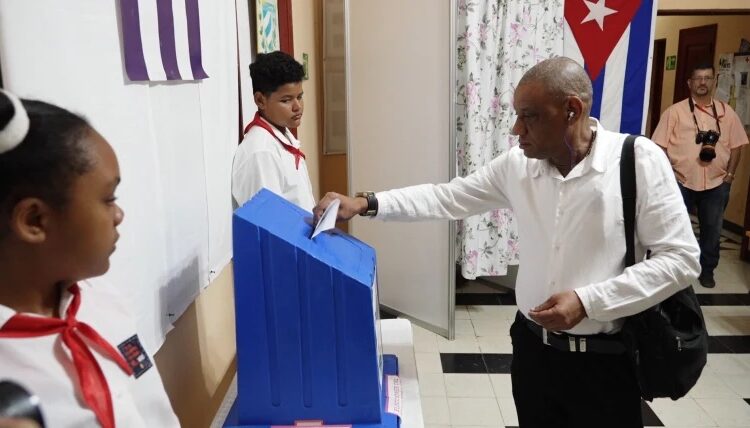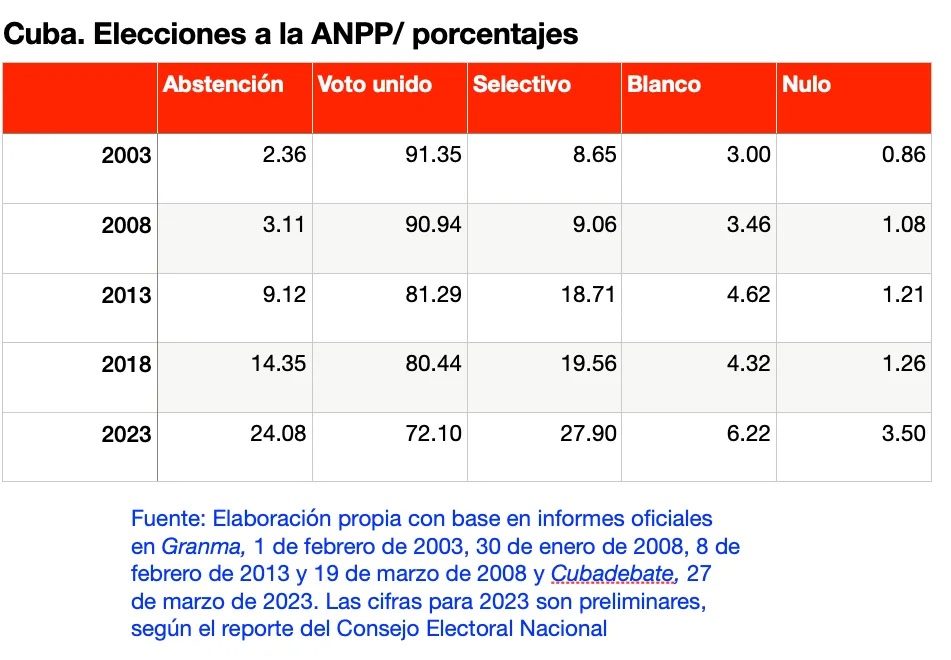
Cuba: A critical and plural society (+Español)
By Gerardo Arreola / Medium
The official results of this past Sunday’s election in Cuba confirm a growing expression of criticism and pluralism in that society, even within the narrow limits of the system.
The trend is in stark contrast to the days of staggering results, close to 100 percent, still on record two decades ago.
With only one legal party, no debate on any issue, with only one candidate for each position, and therefore with a composition of elected officials already known in advance, elections still have minimal room for individual decision.
In the absence of a contrast of opinions or projects between the candidates and with everything resolved months before, the government has turned these exercises into virtual referendums.
The official propaganda calls for the polls expressly to show adherence to the political system and leadership.
Before election day, the candidates usually visit the areas that they are going to represent in the National Assembly of People’s Power (ANPP, the unicameral parliament) to speak with their potential voters and urge them to vote. This time that deployment was clearly more intense.
The “United Vote”
Part of the reactions of the Cuban leadership to the post-Soviet crisis, in the early 1990s, was a new electoral model.
Among the variants adopted in 1991, in the lists for the ANPP the citizen could vote for one, for several or for all the candidates of a constituency or not to do so for any.
As the first election under this new model approached, Fidel Castro called attention to what seemed like an opening for discrepancy.
In a meeting with candidates on February 20, 1993, Castro urged that citizens not exercise that minimum selection capacity and asked that the vote be equal for all applicants.
He considered that selecting one over others was unfair to those who were not chosen and he also put this part of the process on the referendum scale.
“We found the correct strategy by stating that the patriot vote, the revolutionary vote should not be divided, that it should not be dispersed and the negative consequences and injustices that the dispersion and division of that vote could entail. The need for a united vote was evident,” said Castro.
In the successive national elections, the “united vote” became as important or more than the election day itself. In the official discourse, going to vote and voting “united” has been the expression of support for the system.
Conversely, abstention or refusal to vote for a candidate (the “selective vote”) is the narrow corridor through which a citizen can show some type of disagreement or discrepancy with the system or with the postulates.
Under these rules, official attention is focused on the proportion of voters and the dimension of the “united vote”.
According to the preliminary results on the morning of Monday, March 27, the comparison with the elections of two decades ago shows that abstention has grown a little more than ten times; the “united vote” has been reduced by a fifth and the “selective vote” has grown by more than three times.
Until 2008, blank ballots and annulled votes maintained a stable and insignificant trend, but this Sunday both indicators showed notable movement.
Compared to the 2003 elections, this time the number of blank ballots doubled and the voided ones increased by more than three times.
The degree of electoral participation in Cuba compares very favorably with the rest of Latin America, but its contrast with the era of almost one hundred percent is already clear.
These were also the first national elections after the popular protests that started in July 2021 and which resulted in more than a thousand arrests and hundreds prosecuted and sentenced to up to 30 years in prison.
They are different samples of the criticism and pluralism of the actually existing Cuban society.
Gerardo Arreola is a Mexican journalist. Author of ‘Cuba. The future under debate.’ Twitter: @GerardoArreola. Translation to English by Progreso Weekly. From Del Gran Caribe, La Jornada, México.
*****
Versión en Español:
Cuba: sociedad crítica y plural
Los resultados oficiales de la elección de este domingo en Cuba confirman una creciente expresión de crítica y pluralismo en la sociedad, aún dentro de los estrechos límites del sistema.
La tendencia es un agudo contraste con la época de resultados apabullantes, cercanos al cien por ciento, que todavía se registraban hace dos décadas.
Con un solo partido legal, sin debate sobre ningún tema, con un único candidato para cada puesto y, por tanto, con una composición de funcionarios electos ya conocida de antemano, las elecciones todavía tienen un mínimo margen para la decisión individual.
A falta de un contraste de opiniones o proyectos entre los candidatos y con todo resuelto meses antes, el gobierno ha convertido estos ejercicios en virtuales referendos.
La propaganda oficial llama a las urnas expresamente para mostrar la adhesión al sistema político y a la dirigencia.
Antes de la jornada electoral, los candidatos suelen visitar las zonas que van a representar en la Asamblea Nacional del Poder Popular (ANPP, parlamento unicameral) para hablar con sus potenciales electores e instarlos al voto. Esta vez ese despliegue fue claramente más intenso.
El “voto unido”
Parte de las reacciones de la dirigencia cubana a la crisis post-soviética, a principios de los años noventa, fue un nuevo modelo electoral.
Entre las variantes adoptadas en 1991, en las listas para la ANPP el ciudadano podía votar por uno, por varios o por todos los candidatos de una circunscripción o no hacerlo por ninguno.
Al aproximarse la primera elección bajo ese nuevo modelo, Fidel Castro llamó la atención sobre eso que parecía una rendija para la discrepancia.
En una reunión con candidatos, el 20 de febrero de 1993, Castro instó a evitar que el ciudadano ejerciera esa mínima capacidad de selección y pidió que el voto fuera por igual para todos los aspirantes.
Consideraba que seleccionar a uno sobre otros era injusto con los no elegidos y puso esta parte del proceso también en la balanza refrendaria.
“Encontramos la estrategia correcta al plantear que el voto patriota, el voto revolucionario no debía dividirse, que no debía dispersarse y las consecuencias negativas y las injusticias que podía entrañar la dispersión y la división de ese voto. La necesidad del voto unido era evidente”.
En las sucesivas elecciones nacionales, el “voto unido” se volvió tan importante o más que la propia jornada comicial. En el discurso oficial, ir a votar y votar “unido” ha sido la expresión del respaldo al sistema.
En sentido contrario, la abstención o la negativa del voto para algún candidato (el “voto selectivo”) son el estrecho pasillo por el cual un ciudadano puede mostrar algún tipo de inconformidad o discrepancia, con el sistema o con los postulados.
Bajo estas reglas, la atención oficial se centra en la proporción de votantes y la dimensión del “voto unido”.
 De acuerdo con los resultados preliminares de la mañana del lunes 27 de marzo, la comparación con las elecciones de hace dos décadas muestra que la abstención ha crecido en poco más de diez veces; el “voto unido” se ha reducido en una quinta parte y el “voto selectivo” creció en más de tres veces.
De acuerdo con los resultados preliminares de la mañana del lunes 27 de marzo, la comparación con las elecciones de hace dos décadas muestra que la abstención ha crecido en poco más de diez veces; el “voto unido” se ha reducido en una quinta parte y el “voto selectivo” creció en más de tres veces.
Hasta 2008 las boletas en blanco y los votos anulados mantenían una tendencia estable y poco significativa, pero este domingo ambos indicadores tuvieron un notable movimiento.
Comparados con los comicios de 2003, esta vez las boletas en blanco se duplicaron y las anuladas aumentaron en más de tres veces.
El grado de participación electoral en Cuba se compara muy favorablemente con el resto de América Latina, pero ya es claro su contraste con la era del casi cien por ciento.
Estas fueron, además, las primeras elecciones nacionales después de las protestas populares que arrancaron en julio de 2021 y que arrojaron más de mil detenidos y cientos de procesados y sentenciados a penas de hasta 30 años de cárcel.
Son diferentes muestras de la crítica y el pluralismo de la sociedad cubana realmente existente.


